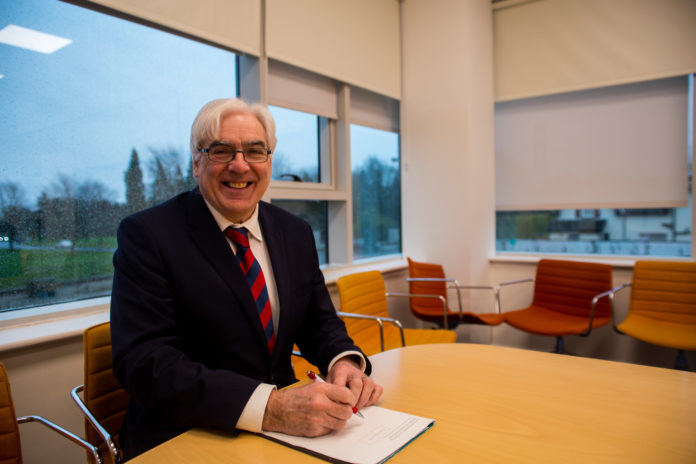
As a former teacher, George O’Callaghan may well reflect on the career trajectory that brought him to the stage where he has a €90 million budget to deliver education and training services across two counties.
When the Vocational Education Committees in Clare, Limerick City and County merged to form the LCETB in 2013, there was a determination that it would result in a stronger voice for the region.
Continue reading below…
“The whole exercise was to rationalise and refocus the education and training function of what were then the VECs and to give them a better and more regional focus in terms of what they were doing.
Then, in 2014, some of the training functions that were the responsibility of FÁS were transferred to the LCETB along with the Raheen and Shannon training centres in Raheen and Shannon.
With 9,500 post primary students and up to 25,000 adult learners, the LCETB has 30 different centres, 18 of which are schools that offer further education and training through Youthreach programmes, vocational training schemes and back to education initiatives.
“We have a significant presence in the region and we probably have the largest number of learners and students when you combine them all together, but our reach is to every community from the West Clare coast down to the Kerry and Cork borders.
“Demand for post-primary school places is increasing year by year, as nationally an extra 65,000 school places will be required by 2025.
“In the Limerick and Clare area, this demand is reflected in the need to provide over 3,500 school places in the coming years. The LCETB is investing more than €90 million over the next number of years in meeting local education needs through the provision of new schools and the improvement of education facilities across a range of schools and education centres.”
Mr O’Callaghan, who is a former principal of St Mary’s Secondary School in Newport, said that the LCETB has embarked on an ambitious school building programme with an investment of over €86 million.
One of the biggest projects is the new school building for Coláiste Chiaráin in Croom which is due for completion at the end of the year.
Gaelcholáiste Luimnigh on Clare Street and a new primary school in Monaleen, as well as projects in Shannon, Ennis and the Steiner School in Scarriff, are just a few of the extensive list of projects in the frame.
“This investment plan will have a huge impact on the social fabric of the area by providing much needed school places for our children and will have a major impact, not only on education delivery but also on the economic life of the region”.
“It is providing more jobs in the building and delivery phases in the short-term, as well as more employment opportunities in the increased number of teaching posts being filled.
“There is also a positive impact on local communities through increased economic activity as well as improving the facilities in which the children of the region are educated.
“We are also focusing a lot on developing pathways to third level through apprenticeships and career traineeships and we try to replicate that in other areas as well.
“As we are almost at full employment, our focus is also about working with companies re-skilling, up-skilling as well as advancing the knowledge base.
“We are also creating pipelines for the third level colleges and have a memorandums of understanding with LIT through which our learners will have a gateway in to the college. We are developing similar arrangements with Mary I and UL.
“We want to be engaged with all the communities across the region by offering them pathways to education and progression routes across the system from the early levels.”
“A partnership with Clenn Construction means that the LCETB is training their workers and this is developing the links that would see us as the ‘go to’ people for training exercises. We are working with a company in Shannon to train people to paint aircraft and up-skill 200 employees.”
“Links to Troy Studios allowed us to train and re-skill carpenters and electricians for set design work, so we see ourselves as having that added value.
“You constantly have to be ahead of the curve in terms of further education. The training division under Paul Patton is constantly looking at new ways of providing an enhanced service.
“It is very challenging and exciting at the same time because you are actually plugged in to quite a lot of parts of the regional economy as well.
“Our role is much expanded from the narrow lanes of before and it is essential for us to be part of the resurgence of Limerick and the region.
“The whole region has progressed hugely in the last few years in terms of employment and inward investment and that has meant that we are part of that framework and making a major contribution towards it.
“We feel we are making a contribution to the community because we have the tools to be able to do that.”
Advising those embarking on the educational pathways and the challenges they face, Mr O’Callaghan said that students should explore all the options that are available.
“Traditionally, we have looked at primary to post primary to third level as a direct path but there are further opportunities on pathways that can lead to areas where people may be very comfortable in and succeed in.”
“Apprenticeships and traineeships allow people to garner a lot of experience. The pipeline isn’t narrow anymore as there is quite a variety out there.”
“Any pressure put on post primary students derives from the points race because you need to achieve a certain amount and if you don’t, then you don’t get into third level.
“That suits some, but for others, it puts a lot of pressure on them when they don’t need it because there are opportunities and alternatives.
“You can find programmes to help you get the tools and skills and perhaps allow you to have a better picture of where you want to go.
“A lot of people go into third level and there is a significant drop out because they’re not ready for the change, so we can help with that.”










